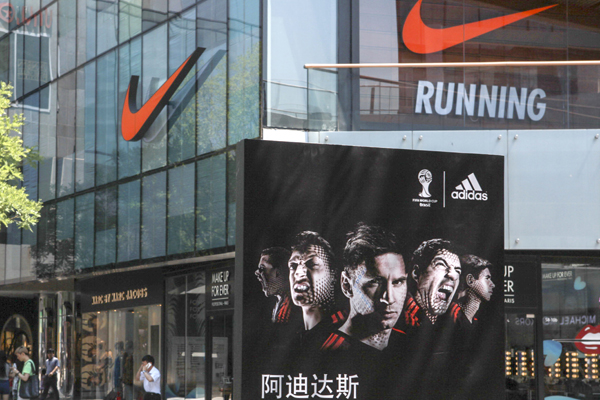Rivals make it a tough year for Nike
 0 Comment(s)
0 Comment(s) Print
Print E-mail China Daily, October 17, 2016
E-mail China Daily, October 17, 2016
|
|
|
Adidas AG's advertising billboard stands together with a Nike Inc store in Beijing. [Photo by Wang Goudan/For China Daily] |
One of the longstanding darlings of Wall Street -- praised for its advertising clout and product innovation -- has had a rough year. The shares are down 13 percent in 2016 as analysts and investors fret over market-share losses to Adidas AG and Under Armour Inc in the United States, its largest region.
Nike had been rolling since the recession -- even in the face of challenges from Adidas and Under Armour -- with the stock averaging annual gains of 26 percent over the past seven years. But 2016 has been a different story, with its shares sinking while the broader market hits record highs. On one flank, Under Armour has attacked its lucrative basketball-shoe business with the success of its Stephen Curry line. On the other, Adidas has drawn away some of its casual business by teaming up with rapper Kanye West and reinvigorating retro styles like Superstar. The German company also has taken a page from the Nike playbook and turned Boost, a performance running-shoe line, into a monster lifestyle hit.
"There is more competition from brands that didn't have the cachet they do now," said Chen Grazutis, an analyst at Bloomberg Intelligence. The rivals have also hurt Nike's ability to charge premium prices, prompting it to offer some items for less, he said.
Exacerbating Nike's struggles is shoppers' increasing preference for classic and casual styles over performance products designed for actual athletic use, according to Matt Powell, an analyst for researcher NPD Group.
For several years, the entire running-shoe industry was helped by people who bought high-tech running shoes for everyday wear, not to train for half marathons. Now those consumers are turning to casual sneakers like Adidas's Stan Smith line. That shift not only helps Nike's current largest adversary, but also threatens to saddle Nike with new rivals such as casual-footwear makers, including Steve Madden Ltd, that don't even have performance businesses, Powell said.
"It lets brands that don't have a performance strategy in the door," Powell said.
Of utmost interest to investors will be how Nike performs in North America. Throughout a turbulent period in China and slowdowns in Europe, Nike's home base has reassured investors of its dominance. The company increased annual sales 10 percent or more from fiscal years 2011 to 2015. But growth slowed to 7.4 percent in the fiscal year through May.
Shoe retailer Finish Line Inc only added to doubts about Nike's home market when it reported second-quarter results by the end of last month. The US-based chain said sales of Nike's premium basketball shoes fell in the period, and CEO Sam Sato sang the praises of Nike's competition. He called the performance of Under Armour's latest Curry shoes "tremendous" and said Adidas remained "on fire."
Research and discussions with industry sources "point to Adidas and Under Armour continuing to gain share at Nike's expense," Lyon said in the note. He cut his 12-month price target on the stock to $52 from $56.
"Our concerns on Nike are mounting," Lyon said. "History has shown that brand shifts take a long time to materialize, and similarly a long time to revert back."







Go to Forum >>0 Comment(s)